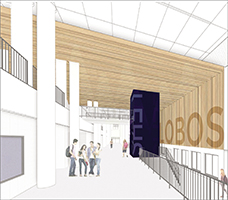Building a School's Brand
October 01, 2017
How smart K-12 schools revitalize their buildings and identity
 The auditorium wall inside Martin Luther King Jr. Middle School in Atlanta features images of the civil rights leader alongside many of his most inspirational quotations.
The auditorium wall inside Martin Luther King Jr. Middle School in Atlanta features images of the civil rights leader alongside many of his most inspirational quotations.
On the first day of the 2016-17 school year, an anxious throng of teens waited to enter their newly redesigned school building in downtown Atlanta’s Grant Park neighborhood.
A mother and her 13-year-old twin daughters stood at the front of the line. When the doors opened, the mother stopped short in the lobby while students and parents filed past. She stared in awe at daylight streaming into the formerly window-deprived Martin Luther King Jr. Middle School. She was equally taken with the wash of color, images, murals and inspirational messages that burst forth.
This building looked and felt nothing like the middle school she attended — in the very same facility — years ago when she was 13.
Staying Relevant
The smartest companies know the importance of refreshing their brands to stay relevant in changing times. Consider the branding evolution that Apple experienced since its founding — progressing from “The Power To Be Your Best” to “Here’s To The Crazy Ones” to “Think Different.” To remain meaningful to their constituents, K-12 schools should consider the benefits they, too, can get from brand renewal.
Today’s parents and students speak the language of brands and especially of brand experiences. They favor in-person encounters with brands that are most meaningful in their lives.
Because one of the most powerful platforms for telling a renewed brand story is “place,” the best time to rebrand a school is when its facilities are being redeveloped or refurbished. Refreshed brand elements then can be integrated into the structure itself, making its culture tangible.
Everything has a brand, whether intentionally crafted or not, including every school. A brand is the collective story told by a school’s name, logo, colors, mascot and any other element that distinguishes it from other educational options in its area. A school’s brand reflects its unique DNA and direction.
When designers embed those unique components into the school’s interior and exterior spaces and create a physical experience of the brand, that’s called a “branded environment.” Two facilities tell the story of how this approach is being used in both urban and suburban environments
Urban Renewal

Martin Luther King Jr. Middle School in Atlanta illustrates transformational environmental branding in a renovation project. The school had been closed for two years prior to its grand reopening last fall during which time it went through a significant revamp with 175,000 square feet of renovated structure and a 17,000-square-foot addition
The building was designed originally in the Brutalist style of architecture featuring unadorned concrete with few windows. It looked imposing and impenetrable. The renovated facility has been opened up literally and figuratively, with new windows and other features that increase daylight, improved collaboration spaces and innovative technologies.
In addition to structural changes, the school, which today enrolls 635 middle schoolers, has cultural changes as well. The new design makes direct reference to the civil rights era. Inspirational messages are cohesively composed, and motivational imagery is strategically displayed on the school’s walls and floors through dynamic patterns and colors.
The design highlights attributes of King — self-awareness and achievement, community pride, responsible decision making, nonviolent social change — and, through bold graphic treatment, adds contemporary relevance to King’s legacy. Images of King are featured throughout the building alongside many of his most inspirational quotes.
One major corridor shows an extensive, hand-painted mural of civil and human rights leaders, turning the hallways of the school into reminders of the community’s educational and societal aspirations for the students. Paul Brown, principal of Martin Luther King Jr. Middle School, characterizes the project this way: “Our new facility is a physical representation of our entire school community’s purpose and place.”
Small Town Revival
Little Elm High School’s branding is rooted in its local and regional heritage. The town of Little Elm was founded in 1841 as part of the Republic of Texas. That was when the smart and powerful gray wolf, commonly called the lobo, roamed Texas’ landscape.
Today, the town in the north-central part of Texas has more than 35,000 residents, and its growth prompted the town to reconsider its high school facilities. Honoring the town’s heritage, the lobo is Little Elm High School’s mascot and logo and the greater school community refers to itself as “the wolf pack.” When work began last January on the $15 million Little Elm renovation and addition, the wolf metaphor became the focal point for a rebranding initiative that accompanied the project.

Little Elm’s updated branding includes a cohesively packaged palette of colors, shapes, patterns, icons, text and materials that, working together, tell an authentic and distinctive story. Little Elm’s original navy blue and gold color scheme informs the new color palette. These colors are applied with tonal nuances that match the functional purpose of various spaces within the school.
For instance, the entrances to the school, which serves 1,900 students in grades 9-12, carry the original navy color, but the gradient lightens as one moves into the communi-ty-oriented social learning spaces. There, color highlights shift from turquoise to yellow-green. Enter the teaching and learning performance areas of the school and the predominant accent color is gold.
Contemporary patterns and textures complement the color scheme and enliven the facility. A halftone pattern (individual dots that, taken as a whole, create a cohesive visual image) of a lobo adorns an exterior window while the 3-D image of a wolf seems to arise from a nearby hallway. In the Lobo Lounge bistro, a wall-size wolf image reminds students of its (and their) graceful strength and intelligence. Digital screens are integrated into the architecture and communicate news, school activities and enhanced graphics/content about competitive events with other schools held within the building.
Color and pattern are combined in multiple locations to highlight the school’s Lobo/wolf-pack theme, spirit and core values. These include “Your Pride. Our Pack,” “We Are Lo-bo Strong,” “We Realize Your Potential. Do You?” and “What Will You Lead?” Along with Kipling’s wolfpack quote, these expressions enhance common areas such as the gym, cafeteria and corridors. Bench nooks cut into hallways and the student lounge walls are painted with reminders of values such as “Excellence,” “Integrity,” “Respect” and “Compassion.”
Cost and Benefits
Perhaps the most surprising fact about branded environments in K-12 education is how much the benefits outweigh the costs to implement. In the case of Martin Luther King Jr. Middle School, the entire environmental branding program — start to finish — cost far less than 1 percent of the $20 million total construction cost.
Meanwhile, the benefits of branded environments for a school are multiple:
- Branding clarifies the common mission and vision for a school and makes it relevant for today’s stakeholders.
- Better branding and branded environments encourage school spirit, which can trigger better student performance. According to a 2014 Harris poll on behalf of Varsity Brands, students with higher levels of school spirit not only outperform their less-spirited peers academically, but they also have greater aspirations for future success.
- Branding a school creates a sense of community belonging, excitement, engagement and ownership for a school, its visitors, its faculty and, most important, its students.
- A branded environment supports emotional intelligence when the space itself is a conduit for social and emotional learning messages.
- A branded environment can facilitate the adoption of a school’s policies and pedagogy.
Touting Values
Every school building tells a story. In the same way that product marketers create brand stories that engage and motivate customers and employees, K-12 school administrators are intentionally transforming buildings, classrooms and hallways to serve as branded environments — messaging platforms — that communicate their organization’s personality, aspirations, values and expectations.
Author
Advertisement
Advertisement
Advertisement
Advertisement


.png?sfvrsn=dde77dc7_3)
